
Du principe anthropique
à l'homme
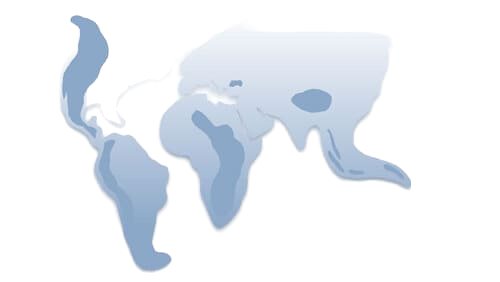


In 1859, Charles Darwin published his famous work On the Origin of Species by Means of Natural Selection, or the Preservation of Favoured Races in the Struggle for Life (1) in which he demonstrated that any form of life comes from more ancient forms, but that evolution is caused by natural selection, simple but revolutionary ideas in these times marked by creationism. Later, the Neo-Darwinians will explain the deep mechanism of evolution by genetic mutations. In the same light, Patrick Delbrouck (2) identifies within the mental pathology the disorders “which correspond to a chronic functioning, apparently unsuitable for the environment, but persisting in time and space through the generations”, and about which are asked the question of how, but also the question of why this “disadvantage” continues by natural selection. This last question refers to the field of medical Darwinism. Its application to psychiatry is relatively recent (about twenty years). Concerning psychoses, it consists in learning about the evolutionary interest which the productive and/or deficient pathologies would show; (…) immediately, the question which this theory would answer is radically different from the one asked by the usual psychopathological research, even if both focus on the “origin” of mental disorders. Darwinism is not interested in “how” one becomes psychotic? And focuses on “why” (…)? The question we are going to ask here is why evolution has at all times generated retro adaptations to marine life, more and more as we get away from fish in the phylum, and what advantages, in terms or survival of the human species, can bring the persistence of autistic children, who moreover have a negative influence on human fertility, since a priori they do not reproduce. In short, they are eliminated, but they come back!
Actually, the evolution of the vertebrate branch did not only occur in the direction of the scheduled conquest of the land mass, that is from the air environment as opposed to the aquatic environment, but also in the direction of a periodical return to the aquatic environment, at the cost of a delicate adaptation backwards. Foreseeing Nature seems to have safeguarded ( in the nearly computer-based meaning), through a progressive return to the bosom of the original sea, one or several species per class of terrestrial vertebrates , in case some deep modifications of the air environment would risk to annihilate its work (Table 1).
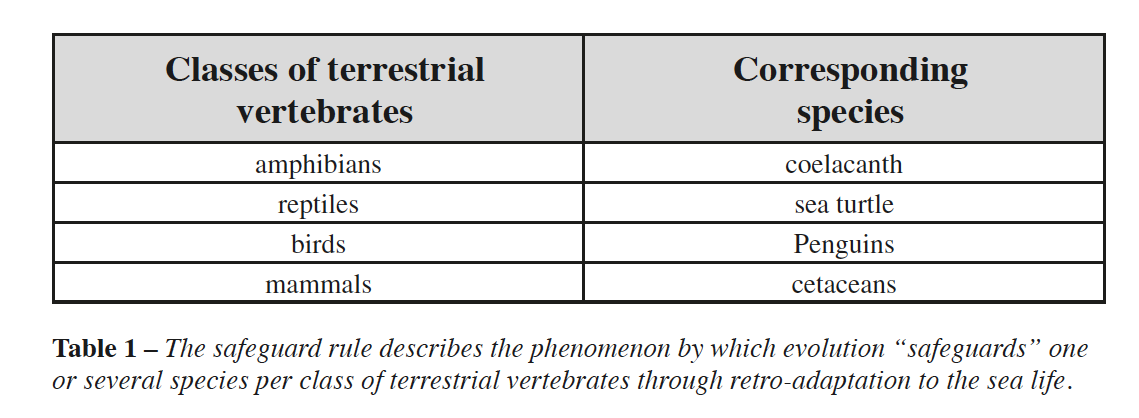
It could be the case of the coelacanth, a real living fossil, whose draft limbs and lungs evoke the class amphibians, and which still lives off the Comoros. It was the case for the ichthyosaurus, a sea reptile from the Secondary Era, which showed many characters of convergence with dolphins, but a vertical tail like fish (picture 1).
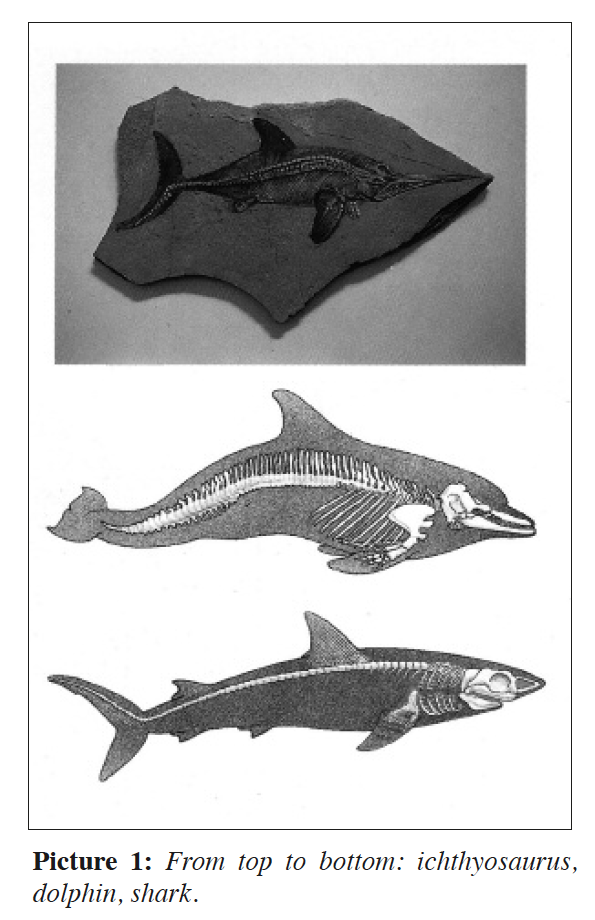
It is still the case for the class of reptiles, sea turtles (hawksbill turtles, leatherback turtles). It is the case for the penguin, a swimming bird able to dive at a depth of 200 meters. The great auk, exterminated during the XIXth century, was also unable to fly. It is of course the case for the marine mammal: cetaceans (whale, dolphin) and pinnipeds (otter, seal). Cetaceans do not move on land, unlike pinnipeds which can still crawl on ground, but exclusively swim thanks to the flapping of a powerful horizontal tail, which distinguish them from fish (vertical tail) in spite of obvious morphological convergences (picture 2).
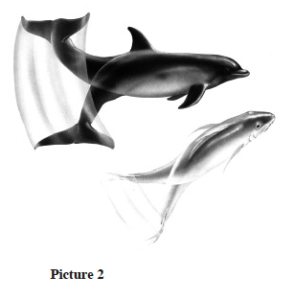
They do not have vocal chords, which would be useless in a non-air environment. On the contrary, an instinct leads cetaceans, particularly odontocetes, (equipped with teeth and not baleens: dolphins, orcas, pilot whales, cachalots), to massively become stranded on gently sloping beaches in all parts of the world, where they die suffocated by their own weight, as if they regularly tempted to recolonize the environment where they remotely came from. This behaviour must be connected with the often amphibious character of pinnipeds, penguins and turtles. It can be more prosaically explained, particularly for the pilot whale, by the existence of an old or sick group leader, who is not strong enough to swim to breathe above water. Thinking to find salvation by beaching, it only finds a brief respite before dying suffocated by its own weight, and on top of that, he attracts the other members of the group, conditioned to follow it blindly, as a young one follows its mother closely during its first year. The solution is then to throw back into the sea all the members, except the failing leader, because it would lead them back inevitably. In any case, considering the frequent stranding of this species, if the land mass is one day recolonized by a cetacean, it will probably be a mutating pilot whale.
So the evolution of the vertebrates seems guided, we could nearly say “scheduled”, behind the apparent proliferation of species, not only by the anthropic principle which leads it as far as Man in a kind of race to complexity, but also by a “safeguard rule” «which leads it to safeguard its work when each class of vertebrates emerge, by a cautious and conservative return to sea life (evolution would not only be creative, but also conservative) in the form of real “living registered diskettes”(via the genome of the preserved species) which would be kept in the sea environment. Some caprices more or less directed by the geological evolution, like the confinement of a population in an insular space leading them progressively to search for their food resources in the sea environment, and so get adapted to it, could explain this constant particularity of biological evolution. We could then dispose of this “marine media
library”:
• The “diskette amphibians” (coelacanth)
• The “diskette reptiles” (sea turtle)
• The “diskette birds” ( penguin)
• The “diskette mammals” ( dolphin)
It is obvious that these marine species must be particularly protected from human predation. But we can also notice that the media library is incomplete and that a diskette is missing, the most important in our point of view and undoubtedly in the evolution’s point of view, the “diskette Man”!
But evolution, which does not run at haphazard but in which haphazard rather seems guided by the anthropic principle, has certainly not forgotten Man, the apex of its creation, in its conservative and safeguarding effort, and we may already have before our eyes the first specimens of the future marine Man : Homo autisticus. However, autistic children are still observed nowadays from an aerial angle, which gives of them a particularly negative vision (3): Their relational disorders are very precocious (from the beginning of life), they do not slip into their mother’s arms like other infants. They do not seek physical contact (aloneness), nor visual contact (they do not look in the face), they do not communicate (mutism, amimia) or repeat in echo the words uttered in front of them (echolalia), they do not cry, they reject any change in their environment (sameness), they learn to walk late, they prefer rocking to and fro in endless stereotyped movements, they do not have any manual preference (defective lateralization), they are incontinent… and of course unsuited to life on earth to which they are submitted. We shall add that they feel no interest, neither for faces nor for human voices, a precocious sign with disastrous relational consequences which we have kept aside, because it has been the subject of a study in functional Nuclear Magnetic Resonance (4,5). This study shows that autistic people use for facial recognition (prosopagnosia) the cortical areas normally implicated in the recognition of neutral objects and for the perception of human voice the areas implicated in the perception of ordinary sounds (instead of activating the specific area of the superior temporal sulcus).
But the observation of these children can be made under an original angle which reveals to be much more positive (table 2), if we consider it under the angle of a pre-adaptation to marine life, which could be explained by the fixing of their own ontogeny at an early stage of the intra uterine foetal life (didn’t Ferenczi talk about “shred of ocean” to name the amniotic fluid?). From this radically new perspective, the autistic child does not slip in his mother’s arms because he does not recognize himself in that “aerial” mother whom he considers as a stranger, and who, for her part, finds him very strange: it is a tragedy for the mother as well as for the child, but the autistic child does not need a mother, he first needs the sea. He does not seek physical contact because the upper limbs are more useful to swim than to embrace somebody else in the sea environment. He does not seek visual contact (in our way) because hydrodynamic adaptation will later impose on him later (during the evolution of his phylum) to move from a binocular front view to a monocular lateral vision. He does not speak because the speech is aerial and inoperative under water (the scuba divers, including myself, communicate by signs).
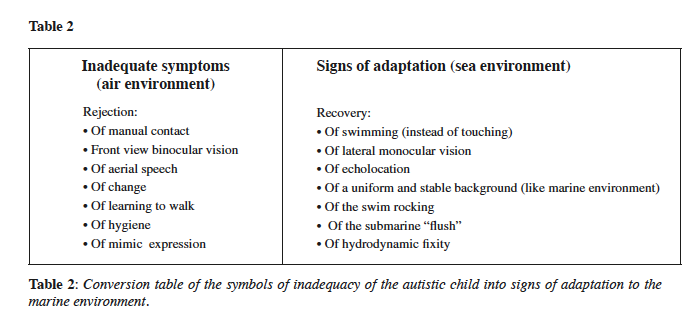
Echolalia itself, when it occurs, would prefigure the mechanisms of echolocation of the sea mammals. The phonetic stereotypies, when they exist, are repetitive consonants useable under water (because they do not need the opening of the mouth like vowels) and remind of the clicks emitted in bursts by the tooth whales like dolphins. The primitive “clicking” languages of the Bochimans (Bushmen in Afrikaans) and of the Hottentots (stammerers in Afrikaans) would by the way be an interesting intermediate, to understand the communication between whales as well as to communicate with autistic people (without using articulate speech). The tongue clicks used from the age of six by the young blind boy Ben Underwood in California is not used to communicate, but to detect obstacles by echolocation, like dolphins and why not immersed autistic, and shows that this adaptation is possible in one generation only. These two “terrestrial” examples show us that phonetic stereotypies could have a double function, like in the dolphin: communication under water and echolocation, essential guarantees of adaptation to sea life, to avoid being mute and blind (without a mask) in this apparently hostile environment.
The autistic child does not cry, because tears are useless when eyes are permanently bathed in salted water. He rejects any change around himself, because the deep marine environment is a stable and nearly unchanging environment. By the way it is the first impression felt by any scuba diver: no change of weather or season under the sea, no wind which rises and folds vegetation, no rain, snow or hail, no thunderstorm and lighting, no torrent or waterfall, no swell or surf like on surface, but muffled noises and cushioned falls, drop-offs where one does not fall (thanks to buoyancy), movements slowed down by pressure…the autistic child orients himself well in space, because he is ready to evolve in a three-dimensional environment. He is not motivated to learn to walk, because walking is useless in the open sea. On the contrary he loves rocking his whole body to and fro, because it is the best way to move when the body is totally immersed in water (ex: butterfly stroke or dolphin’s swimming). The rocking stereotypies thus become sketches of swimming movements (undulations of the body which successively plunges and emerges) suddenly adapted to this new environment. It is worth noting that the swimming sagittal rocking of the cetaceans is the most stereotyped in the class of mammals with breathing, to which it is in fact linked (they have to rise up regularly out of water to breathe). So the sagittal rocking of the autistic is not a simple psychomotor stereotypy, it is the prefiguration of an essential movement of survival in the marine environment (swimming and breathing). Another common point, contrary to walking which is a discontinuous movement (we do not fall when we stop and we start again easily), the rocking of the autistic is a continuous movement which can last for hours because, as Louis de Corlieu (the ingenious inventor of swim fins) had demonstrated as early as 1907, the discontinuity of impulse diminishes the efficiency of propulsion in water, and then a continuous movement is preferable, not only to stay hovering and to breathe on the surface, but also to save the energy necessary to move forward in water.
Some autistic do not sleep or seem not to sleep and so rock all night, sitting on their beds, reminding us of the continuity of the swimming movements which the sea mammals must make continuously during their sleep, at the risk of drowning ! In fact the dolphin only sleeps with a hemisphere at a time (each hemisphere alternately sleeps during 20 minutes) to go on breathing on the surface (that is why the swimming movements are permanent) and because its breathing is voluntary and not automatic like in Man (to avoid breathing in water or in a wave). It would be interesting to register the electroencephalographic patterns of the sleepless autistic child, in order to detect signs of a persistent but asymmetrical sleep like in these sea mammals. An anomaly we could compare to this vital necessity, which, according to Michel Jouvet, happens in two thirds of healthy individuals, is the dissociation of faces and messages during the REM sleep. It means that we recognize a person in our dream, without understanding what he says, or conversely, we can hear what he says without recognizing him. This anomaly can only be explained because faces are linked to the right hemisphere (spatial recognition), while messages are linked to the left hemisphere (speech centre). This is to say that the brain dreams sometimes with the right hemisphere, sometimes with the left. This natural disposition or rather this predisposition apparently common to the autistic person and to most of the healthy individuals, points out at a similar level the structure of the non-REM sleep in the dolphin, which sleeps alternately with the right hemisphere or the left hemisphere , in order to control his breathing with the awake hemisphere. From alternate dream to alternate sleep, there is only one step which nature has been able to take with some autistic people, as it did with sea mammals. Table 3)…

The disorders presented by the autistic children are very precocious, but it is because in our hypothesis they have to adapt from birth to the marine environment (in which they are supposed to have been born). They are ambidextrous because they will use their hands to swim and not to grasp, and that swimming is a symmetrical movement. They do not have a dominant brain like normal children, for anyway they do not use language, because anyway if one day they have to swim while sleeping, the hemisphere which alternately remains awake will have to be polyvalent. They are incontinent, because whales do not go to the toilet, since, in their environment, the “flush” is used permanently! They do not feel any interest for the expression of faces, for the hydrodynamic stresses will require the fixity of facial features during their regressive evolution inside the marine environment, which has for consequence that even the permanent smile of the Tursiops dolphin is a neutral object deprived of any affective meaning (and so, uninteresting). The scuba divers themselves do not grant any interest to their fellow divers’ faces, deformed or crushed by pressure, and so devoid of significant gestures. Then we can see that the autistic child’s inadequacy is more educational than physiological, provided that we replace an air environment by a marine environment in which we want to educate him. By the way they love going to the swimming-pool or to the seaside, where they are not afraid of immersion, and keep for a long time the primitive reflexes of the “swimming baby”: mouth shut and eyes open. The risk of drowning is very low (under surveillance), and we can say for certain that, when we see how excited they are, that they are happier than in air environment. Finally, their intelligence seems normal, if they are not tested with the usual performance or verbal tests.
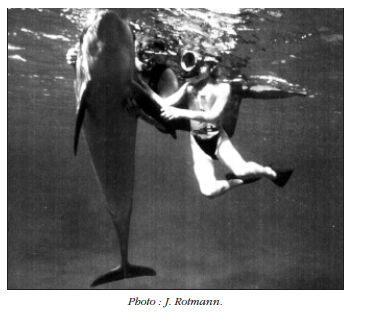
The child of silence could then be actually adapted to the world of silence. A relative silence of course, for even if fish are mute, cetaceans are not (whale songs, dolphin whistles and clicking). Obviously we measure the medical educational consequences which result from this hypothesis. In fact, these implications are already empirically put into practice by the Israeli biologist Roni Zilberg, and by Sophie Donio’s team, supported by the Israeli psychiatrist Daniel Meir, at the Dolphin Reef in Eilat, by the Red Sea (6). The project named “Supportive experience with the aid of dolphins” started in 1991, one year after the opening of the Dolphin Reef, and inspired by an existing project led since 1989 by Doctor David Nathanson in Key Largo (Florida). This program was taking care in May 2002, when I went there, of autistic children and adolescents who were in contact with thirteen dolphins of the Tursiops truncatus species (photo) living in an enclosed natural space of one hectare, eighteen meters deep (but it is not closed: There is a gate, which makes this enclosure original, with a net through which the fish necessary for their feeding can pass). The aim is not to change these children into apprentice dolphins or Marine Men, but to better the communication between the child and his parents or his therapist via this animal in which he happily identifies and which naturally comes to him and his “dolphin trainer” as early as the first contacts.
His equipment is usually basic: a wet suit which, associated with the exceptional salinity of the Red Sea (40 g/l) provides buoyancy for the patient. But, for longer care, we could also imagine the traditional “snorkelling” equipment: a mask to improve vision, a tuba to get air above his head (like the dolphin’s blowholes), and even welded fins to complete the imitation of the animal (horizontal tail), and use the rocking stereotypies of the young autistic in a better way. The most important is especially to re-motivate the child to communication (even to use his verbal capacities) and to provide him the trigger to spur his necessary psychomotor development in an environment suited for his pathology, and prevent him from getting locked in an environment psychosis which will compromise his experience and sterilize his intelligence forever. All the attempts to medical rehabilitation should in fact be initiated in this type of structure, where the sea (25°C on average) is the medium and the dolphin the natural instructor of the autistic child under the supervision of the “dolphin trainer». In this rehabilitative perspective accomplished in an appropriate environment respecting the evolutionary specificity of the autistic child (instead of uselessly standing against it) and even his evolutionary similarities with the cetacean, under strict specialized medical supervision, and without expressed hope of recovery, but only with behavioural adaptation to his dedicated environment, we can then talk about “dolphin-assisted therapy” for the autistic child. Our project would be to transpose this experiment into France, thanks to the technical platform of the Antibes Marineland, even if the seven dolphins which live there are strictly captive and mainly trained for the show. The city of Antibes is by the way twinned with Eilat, and, another strong symbol, Franck Esposito, the Europe champion 2002 of two hundred meters butterfly stroke, or dolphin swimming is a swimmer from Antibes. The therapy would be proposed in the form of floating sessions ,or of swimming with the animal, of stroking, thanks to the mediation of the dolphin’s coach, possibly of feeding, even of towing (tied to the dorsal fin) in the most positive cases. All this with a fluid listening of the sounds issued by the cetaceans, either directly during the session, or indirectly through headphones and immersed microphones. Actually, we can say that the autistic are ill-treated in the whole world, by lack of adapted means available, except by psychiatrists Daniel Meir and David Nathanson (above mentioned), but also by the ethologist Lorenzo von Fersen in the Nuremberg delphinarium (Germany, 1998) and the psychologist Richard Griffioen in the Harderwijk delphinarium (Netherlands, 2001) where I went in August 2002. In France, I would like, in turn, to be able to provide them what they really need in order to live in this air world which understands them so badly, by inability or lack of will to identify with their so strange problem (the strangest undoubtedly of all the mental pathologies).
Choosing the dolphin seemed better to us, even if it is more difficult to carry out, than choosing animals living in air environment (like the horse), for three reasons:
- The marine environment recreates the uterine conditions of life (the pool and the sea water, which remind us of the amniotic fluid) and I noticed that the child must be attracted in water in his mother tongue (for example in Russian, instead of English or Hebrew, if the child is an Israeli Russian immigrant)
- The dolphin is a friendly mammal which expresses a spontaneous desire of contact with the human species, without wanting food (the dolphins in Dolphin Reef are fed at fixed hours 4 times a day, without conditioning link with the therapy, and swim out of the pool to hunt the species they particularly like as soon as they have spotted them with their sonar),
- We can help the autistic child to find the roots of the desire to communicate by playing him the underwater sounds emitted by the cetaceans and captured by microphones placed in the pool which reactivate in him the “in utero” listening which carries the original desire to communicate (fluid listening inspired by the Tomatis method).
We can wonder why no attempt has been carried out with the anthropoid apes (chimpanzee). It is because the great ape has in common with Man the front binocular vision, which drives the autistic’s eyes away and disturbs so much the communication with his congeners, even his own parents.
To finish with, on an ethical level, let us note that in case of a future genetic typing of the disease, we‘ll have to proscribe any recognition mode in utero, and especially any prophylactic treatment by prenatal selection of embryos ( scientific eugenics), whatever would be the cost of managing the handicap. In fact, if evolution constantly keeps this type of pathological constitution in human biodiversity (4 to 5 autistic in 10 000 children in France like in other countries), it is perhaps to preserve the whole human genome in case of major ecological catastrophe on the surface of the immerged land, either of natural origin (ex: fall of a gigantic meteorite) or provoked by Man himself: nuclear war, disappearance of the ozone layer, submersion of the continents caused by ice melting (greenhouse effect), etc. Actually, if we estimate the world population at 6 billion people, including one half living on 30 km large coastal belt, and at 40% the young aged less than fifteen, that means in fact 480 000 autistic children living to the coast line. Even if a small percentage of these children managed, thanks to their pre-adaptation, to survive first in an estuary or lagoon environment close to the (new) coast, then on the open sea, this small contingent would be enough to re-populate the new eco-system, and, through reproduction in the core of this group, to confirm the autistic pre-existing features and so to consolidate the adaptation to the environment. The fact that geneticists suspect the Hox genes (which are also implicated in the neotenic of the pre-chimpanzee into the Australopithecus, then to Man) A1 and B1 on the chromosomes 7 and 17 as provider of autism, actually indicates that it is more an evolving mutation than a disease in the strict sense. It is undoubtedly a new “neoteny”, that is to say, a slowing down of the development rate of the young autistic, which prevents him from metamorphosing into an aerial person, and keeping him at an aquatic level of the foetal development.
Finally we can note that congenital malformations of physical kind, this time, can also predispose to the adaptation to marine life and, combined with autism, could improve this adaptation (Picture 1):
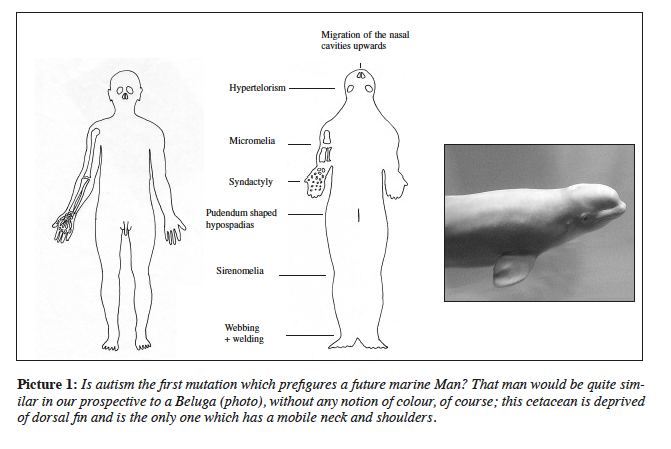
o Hypertelorism, abnormal distance between the eyes which prefigures the lateral sliding of eyes backwards, by hydrodynamic fusiform adaptation (torpedo-like shape);
o The pterygium colli, bilateral stretched from the mastoidial area to the acromial area on each side of the neck (fusiform lift adaptation);
o The symmetrical segmental micromelic, which stops the lengthwise development of the upper limbs (picture)
o The webbing of the fingers (in French, “paume” looks like “palme), or syndactyly, and of the toes;
o The vulvar-like hypospadias, which draws the penis back like in some cetaceans and puts it safely under a pseudo vulvar slit, in order to avoid any asperity creating turbulences;
o The sirenomelia, which welds the lower limbs together from the pubis to the sole of the feet (1/70000 births).
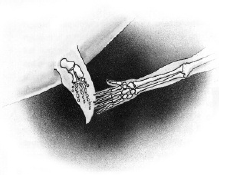
We can also think, according to the saltatatory theory of evolution (Gould), that the combination of this behavioural inadequacy to aerial life represented by autism, and of these various congenital malformations, as well as of new environmental conditions, could lead to a much faster adaptation, maybe as brutal as the trigger element, than we usually think: a real evolutive leap forward in some way.
The mutual tropism and the evolutionary convergences of the autistic person and the dolphin may one day place the delphinids in the centre of the human world. Wasn’t Delphi originally considered as the navel of Earth (omphalos)? Especially as the cases of imprudent swimmers and shipwrecked sailors brought back onto the beach have been numerous since Antiquity, since the rescue of poet Arion thrown overboard off Corinth (close to Delphi), since the rescue of Jonas by the whale which “vomits” him then on the shore (Jon 2). They could in fact play a determining role by rescuing some autistic at the beginning of their retro-adaptation to marine life, in the dramatic circumstances we can imagine.
The idea is not crazier, it is more poetical in fact, than Laurent Mottron’s (autism: another intelligence, 2004) who claims, when he refers to the special capacities of skilful autistic people (ex: calendar calculation), that autism is intended to become a cultural advantage in a simply aerial environment: “There is a bundle of results indicating that the predisposition to autism, and, in a way that has yet to be determined, autism itself, can represent an adaptive advantage. (...) All the areas of information processing for which the autistic are superior to the non-autistic on the perceptive and mnemic level (…) constitute the strongest argument. «This argument in the form of a “hoax”, using the discourteous term employed by the Quebec Mottron towards my own works, is used as scientific cover to colossal interests in support of the TEACCH method, which pretends to (re)educate the autistic children with a great deal of specialized personnel (non-psychiatric) and institutions greatly subsidized by public budget. So there is a real market on suffering autistic children and their parents which the TEACCH method (Schopler), psychoanalysis which is the oldest method (Bettelheim) and dolphin-assisted therapy which is the most recent (Nathanson) are fighting over. It is partly the reason of the failure of my project of management of young autistic in the Antibes Marineland. Therefore, I summarize: 1° for Mottron, autism is an advantaging adaptation to the modern world; 2° for Bettelheim, autism is an advantaging adaptation to the sea world; For Bettelheim, the autistic person is an “empty fortress”; for me, the autistic would instead be a “submarine in dry dock”. Make your choice!